The Pharmacy of St. Saviour in Jerusalem
A singular patrimony of knowledge in the Middle East
A rich collection of jugs, saplings, apothecary vases and jars, pharmacopoeia, recipes and carefully preserved medical records make up the inventory of the Pharmacy of the Monastery of St. Saviour in Jerusalem. This pharmacy has served the needs of friars and pilgrims, the city’s Christian community, and its entire population regardless of creed, for several centuries.
This short multimedia exhibition presents the history of the Pharmacy, some elements of the collection of vases with their respective functions and some pages of ancient recipe books and antidotaries that continued up to nowadays
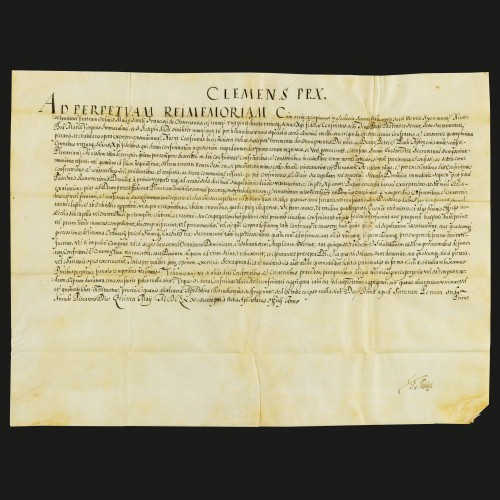
Bull of Clement X
In the past, the impossibility of resorting to local doctors obliged the friars of the Holy Land to train religious to be experts in the arts of medicine and pharmaceuticals who could work for the benefit of the community; the first evidence dates back to 1480, when Pope Pius II sent Friar Baptiste de Lubeck, a medical expert, to Jerusalem to treat the religious of the Custody. Soon, however, the need was felt to extend medical care to the entire local population.
In favour of this charitable activity Pope Clement X officially expressed himself in the letter Cum sicut dilectus of 7 July 1670, which regulated the exercise of the medical and pharmaceutical activity of the religious of the Holy Land.
Bull « Cum sicut accepimus », Rome, 1670 (Inventroy ASCTS, Tome II, p. 33, n. 90);
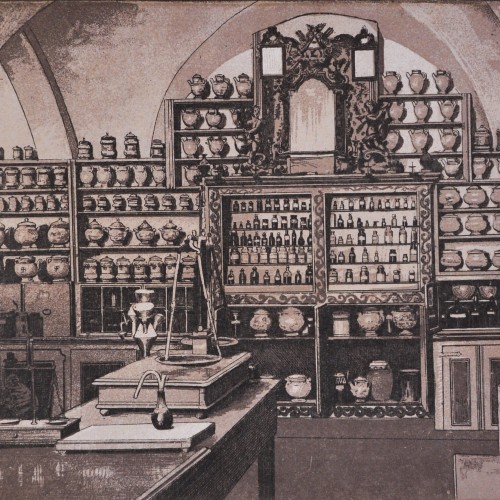
The Pharmacy of St. Saviour
Starting from the 15th century, therefore, we find numerous historical references to the activities of the friars inside the pharmacy of San Salvatore. This remained for a very long time the only pharmacy in Jerusalem and the only one in the Middle East.
“The apothecary is sufficiently equipped with every quality of medicine, purchased with alms from benefactors of the Holy Land and particularly from those of the Most Serene Republic of Venice, to be able to cure and restore the sick”, as Father Horn described it in the first half of the 18th century.
Album Missionis Terrae Sanctae: album Palestino-Seraphicum. SS. Locorum prospectum, religiosa domicilia, elementares pro utroque sexu scholas, alique opera Seraphicae Terrae Sancate Custodiae referens, Jerusalem, 1882;
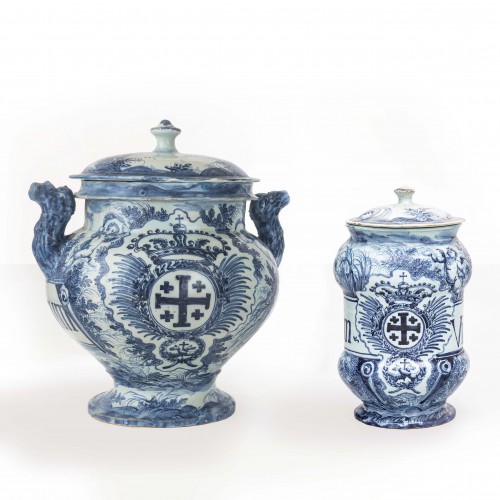
Vases of the Custody of the Holy Land
Over the centuries the pharmaceutical laboratory became more and more active and the medical knowledge of the friars became more profo. The collection preserved to this day, has a large number of specimens made especially for the Custody of the Holy Land, as evidenced by those on which the cross of Jerusalem and the Franciscan emblem are represented.
Electoral vase and sapling in majolica, with decorations and shield with the coat of arms of the Custody of the Holy Land, Savona production by Giacomo Boselli, 1791;
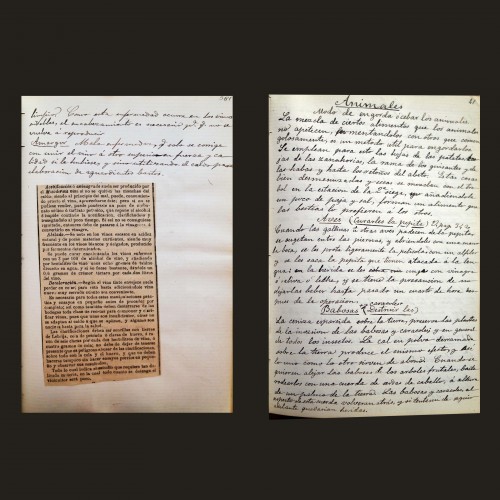
The result of international cooperation
The supply of this important laboratory with apparatuses and instruments (stoves, stills, vases and vessels) as well as in raw materials could not have been realised if the Custody of the Holy Land had not benefited from international cooperation. In fact, the old entry records indicate the arrival of glass and ceramic vases from Spain, metal vases from Germany and Austria, stills from Venice, all varieties of medicinal plants, balms and spices supplied by the great Italian cities, but above all from Spain and Portugal.
Recipe book in Spanish, divided into several sections, containing not only the recipes but also the transcription of some letters of correspondence entertained by the pharmacist of St. Saviour with Father Novoa, of the province of Santiago de Compostela in 1910, a small handwritten calendar and newspaper clippings, from the General Library of the Custody of the Holy Land, 20th century;
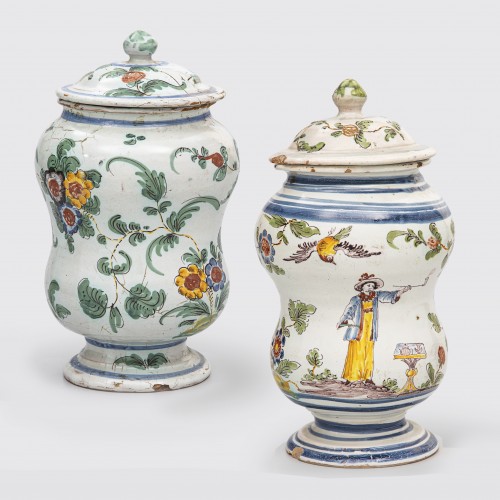
Pharmacy in the economic and commercial system
We cannot rule out the possibility that the Franciscan health personnel working in the pharmacy of San Salvatore may have had an influence in directing the choices regarding the purchase of the vases, especially from the relationship that the Franciscans had with the commissioners of the Holy Land of Genoa and Venice.
The mercantile relationship which we ought to consider behind the commercialization of majolica vases involves different activities and different interests. Think for example, in addition to the activities of the ceramics workshop—and therefore the relationship with the manufacturer—of the difficulties of transporting the goods from the place of production to a port in the Middle East, and from the latter to Jerusalem.
Most of the jars preserved in the Farmacia di San Salvatore are of Venetian and Ligurian production, but there are also other examples of production from Pesaro, Abruzzo and Sicily.
Alberelli in majolica with lid, decorated with vegetable motifs and male figure, Pesaro workshop of Callegari and Casari, ca. 1775;
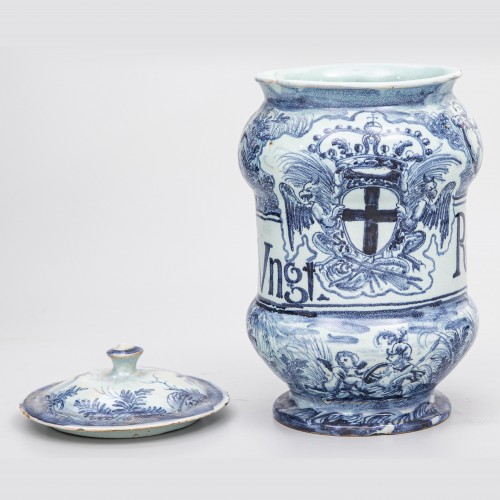
The vases of Genoa
Some pieces were commissioned by the Custody of the Holy Land to the company Boselli of Savona, near Genoa, Italy; the collection was then enriched with additional pieces from Venice. The Savona vases date from the 17th century to the 19th century. Many of them have the company’s trademark on the bottom (a falcon with a crown) and also the signature: “Giacomo Boselli Savona 1791“. On the face of the jugs, together with the name of the drug and the decorations, are painted the coat of arms of the Custody of the Holy Land and that of the Republic of Genoa.
Alberello in majolica of Unguento di Resina with decorations and coat of arms of the Republic of Genoa, Savona production by Giacomo Boselli, 1791;
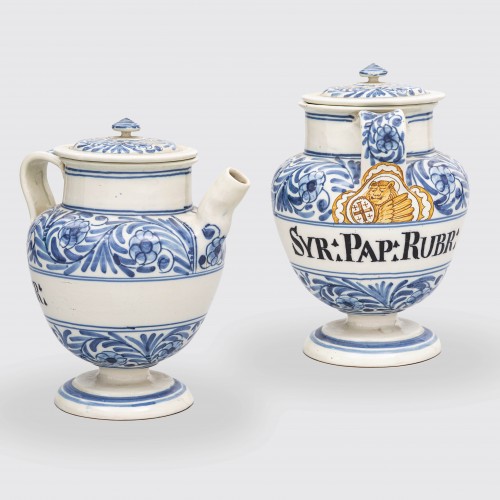
The vases of Venice
Other vases, coming from Venetian manufacture, constitute a rather conspicuous nucleus.
There are doubts about their dating (between the 18th and 19th centuries), and even about their production: there are, in fact, no real brands, as in the case of Ligurian vases, which inform us about the place of production. The only symbol that repeats itself identically on all the vases is the winged lion. This could be a symbol that indicates Venice as the place of production, but it could also indicate that Venice was only the client of this production or that it supplied ingredients, herbs or medicines.
Red Poppy Syrup majolica “Chevrette”, with decorations, Venetian coat of arms and shield with Holy Land cross, 18th century;
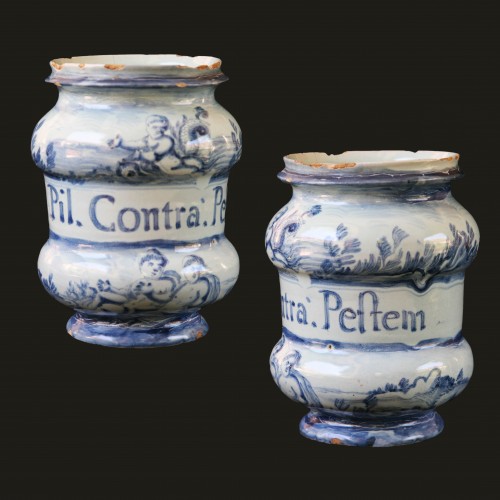
Albarello
This type of vase is mostly cylindrical in shape with a narrower mouth: it was used for ointments, salts, drugs, pharmacy products. The collection shows us that the vessel functions of the sapling could be the most varied according to the size and quantity of the medicines. There are in fact smaller saplings that contained pills.
Albarello in majolica of pestilential pills, decorated with plant, animal and cupid motifs, Savona workshop, ca. 1670;
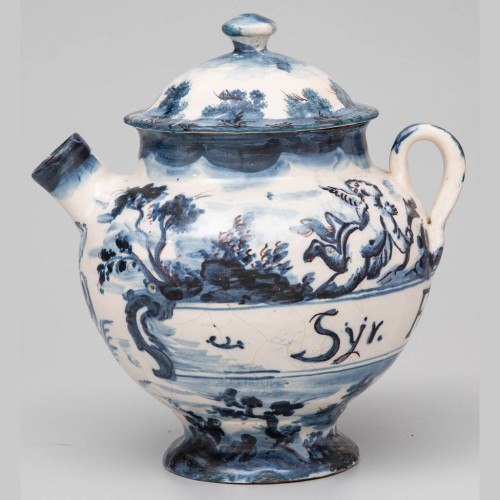
Chevrette
The morphology of the chevrette allows us immediately to understand how to use it, as well as its function, limiting it to that of a container suitable to contain substances of a sufficiently fluid consistency to be poured. It is the jar for oils and syrups. The sizes of the jars are quite homogeneous.
JChevrette in majolica of Cedar Acid Sauce decorated with vegetal elements and cupids, probably produced by the Angelo Levantino workshop in Savona, ca. 1640;
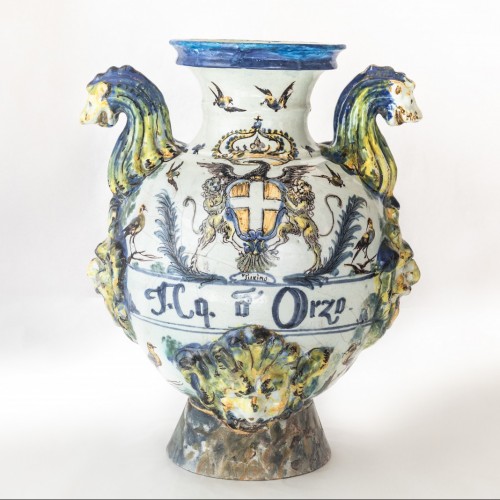
Covered jar with two handles
It is a very large jar, partially or totally filled, which also had to have a considerable weight and which made its movements very limited. Its destination could not therefore be that of a container subjected to frequent movements, but rather that of a container that had to be placed on one of the fillings in the spice rack and remain fixed there, with the lower part placed at a height such that it could be easily available; in fact, just above the foot, it has, unique in terms of vessel morphology, a hole designed to contain a canula of a sturdy bronze tap fixed to the wall.
Covered jar with two handles in majolica, with inscription of contents and decorated with heraldic and animal insignia, Savona workshop, ca. 1750;
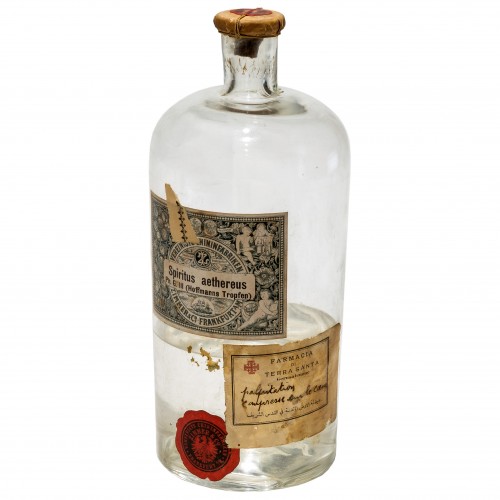
Pharmaceutical formulas
Thanks to the study of pharmacy vases, we can get an idea of how much the friars, engaged in these activities, had with time reached a certain degree of organization and competence: the morphology of the objects gives us information about their specific functionality, the characteristics of their contents and allows us to understand the pharmaceutical forms used in the past, their composition, their methods of preparation and their activity.
Glass bottle by Spiritus Aethereus, German production, 20th century;
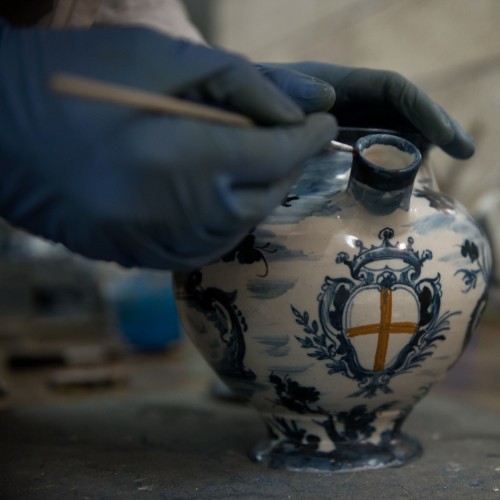
The study of the collection
The study of the pharmacy and medical collections also offers us a broad spectrum of historical information from various points of view: the artistic one (study of manufacturing, decoration, technique), the economic one (international trade relations), the pharmacological and medical one (closely linked to epidemiological events), and finally the social one. It must be borne in mind, in fact, that the entire pharmacy inventory is an important testimony to the epidemiological conditions of the past, which in turn are influenced and depend on numerous factors. They provide us with information on nutrition, hygiene levels, geographical location and economic conditions in a given historical and social context.
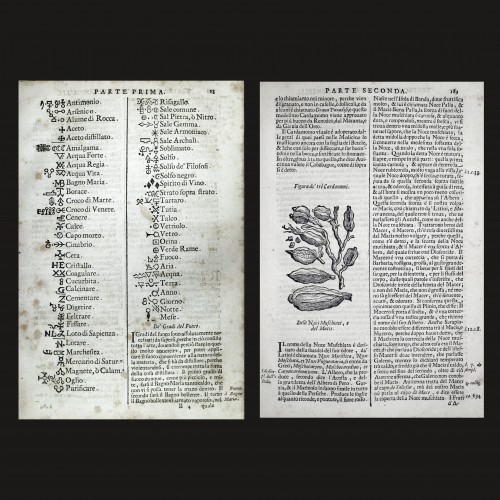
Recipebooks and Antidotes
The study of vases, in parallel with the study of antidotaries and recipe-books between 1500 and 1800, has been an important investigative tool for the history of medicine. In fact, it was found that the inscriptions corresponded to formulas in which a considerable quantity of ingredients were included. This study, compared with that of contemporary pharmacopoeia, suggests that sometimes the so-called officinal medicines, i.e. preparations and medicines stored in pharmacies, were part of much more complex formulas: these were the so-called masterly medicines which, depending on the doctor’s art, mixed different medicines together, to give them a composition and form adapted to the special purpose the doctor wanted to achieve.
Donzelli Giuseppe , Pharmaceutical, teaching and alchemiclal theatre, with Giovanni Giacomo Roggieri, Catalogue of the native plants of the Roman soil, Venice, Gasparo Storti, 1696.This is a vast collection of recipes, chemical and pharmaceutical procedures, botanical, pharmacological and herbalist observations, divided into three parts. From the General Library of the Custody of the Holy Land (MED 33);
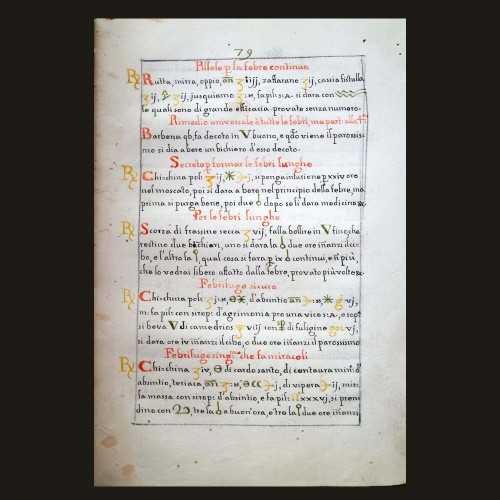
Galenic preparations
In general, the pharmacist received a prescription drawn up by the doctor, which could include medicines stored in the pharmacy (ointments, honeys, preserves, juices, balms, extracts, syrups, powders), but could also sometimes require preparation on the spot. This led to the assumption that the jars and containers inside the pharmacy could be set up in a more or less complex way according to storage times or preparation times (which could be very long).
Daniele Gatas, Collection of Pharmaceutical Secrets, 1778. The diseases and remedies described, divided into XIX chapters, are accompanied by chemical and alchemical symbols, of which the explanation is given. From the General Library of the Custody of the Holy Land (Manuscript MS. 76);
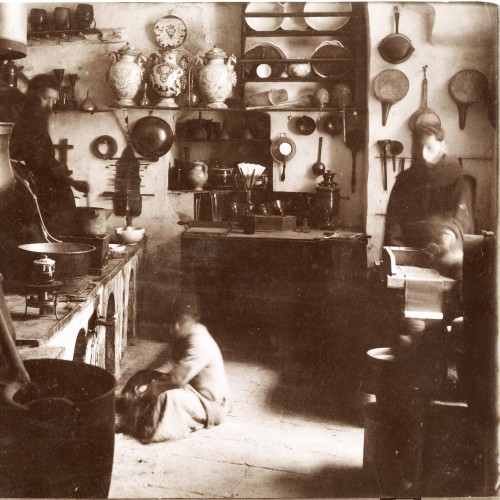
The Jerusalem Balm
On the other hand, the friars also became specialists in galenic and phytotherapeutic art as well as pharmaceutical art, just think of the so-called “Jerusalem Balm“. The use of this medicine was very successful from the 15th century onwards, not only in the Middle East but also in Europe, and it is still used today.
Composed of boswellia, a particular type of plant used for the production of incense, myrrh, aloe and mastic tree, it required a precise preparation and with its significantly anti-inflammatory, antibacterial and antioxidant properties was suitable and used as a panacea to treat various diseases.
Photography of the Laboratory and Pharmaceutical Distillery inside the monastery of San Salvatore;
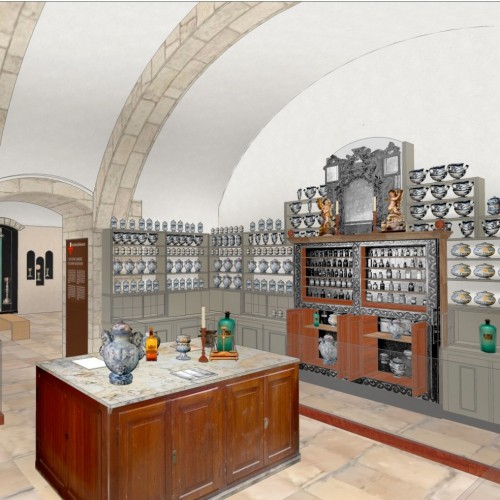
Pharmacy in the new museum
The pharmacy functioned for the people of Jerusalem until the First World War. The difficulty of obtaining supplies of medicines during the war and the opening of other pharmacies in the city led the Custody to put an end to that service which had become obsolete.
The ancient pharmacy will be revived in one of the rooms of the future historical section of the Terra Sancta Museum which, according to a design by museographer Jérôme Dumoux and architect Vincenzo Zuppardo, will help the visitor travel back in time. The study and research carried out so far make it possible to faithfully reconstruct the rooms of the pharmacy, the shelves and the position of the vases.
In the Pharmacy room you will also be able to observe closely the pharmaceutical equipment, touch the reproductions of the apothecary vases and smell the scents of spices and aromas that once cured the inhabitants of Jerusalem.
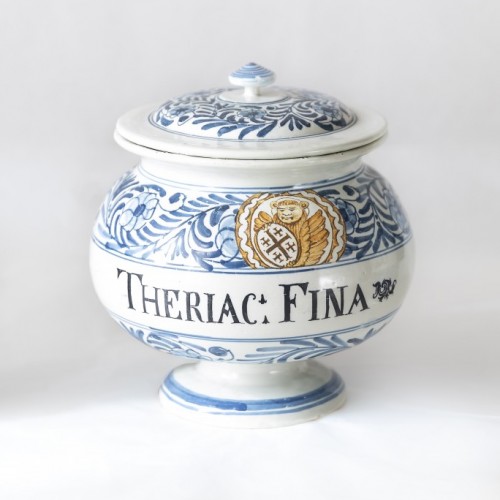
Bibliographical references
-Album Missionis Terrae Sanctae: album Palestino-Seraphicum. SS. Locorum prospectum, religiosa domicilia, elementares pro utroque sexu scholas, alique opera Seraphicae Terrae Sancate Custodiae referens, Jerusalem, 1882;
-G.Farris, A. Storme, Ceramica e farmacia di San Slavatore a Gerusalemme, Genova, 1981;
-Olivier Lafont, “The inventory of the Contents of the Pharmacy of Saint Saviour’s Monastery in Jerusalem, in “Treasure of the Holy Sepulchre”, work published on the occasion of the exhibition “Treasure of the Holy Sepulchre”. Gifts of the European Royal Courts in Jerusalem” presented at the Chateau de Versailles, Silvana Editoriale, 2013;
-In Terrasanta. Dalla Crociata alla custodia dei Luoghi Santi, mostra Palazzo Reale, Artificio Skira, 2000;



